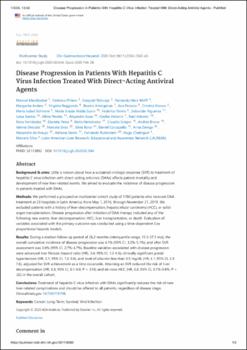| dc.description.abstract | Abstract
Background & aims: Little is known about how a sustained virologic response (SVR) to treatment of hepatitis C virus infection with direct-acting antivirals (DAAs) affects patient mortality and development of new liver-related events. We aimed to evaluate the incidence of disease progression in patients treated with DAAs.
Methods: We performed a prospective multicenter cohort study of 1760 patients who received DAA treatment at 23 hospitals in Latin America, from May 1, 2016, through November 21, 2019. We excluded patients with a history of liver decompensation, hepatocellular carcinoma (HCC), or solid-organ transplantation. Disease progression after initiation of DAA therapy included any of the following new events: liver decompensation, HCC, liver transplantation, or death. Evaluation of variables associated with the primary outcome was conducted using a time-dependent Cox proportional hazards models.
Results: During a median follow-up period of 26.2 months (interquartile range, 15.3-37.5 mo), the overall cumulative incidence of disease progression was 4.1% (95% CI, 3.2%-5.1%), and after SVR assessment was 3.6% (95% CI, 2.7%-4.7%). Baseline variables associated with disease progression were advanced liver fibrosis (hazard ratio [HR], 3.4; 95% CI, 1.2-9.6), clinically significant portal hypertension (HR, 2.1; 95% CI, 1.2-3.8), and level of albumin less than 3.5 mg/dL (HR, 4.1; 95% CI, 2.3-7.6), adjusted for SVR achievement as a time covariable. Attaining an SVR reduced the risk of liver decompensation (HR, 0.3; 95% CI, 0.1-0.8; P = .016) and de novo HCC (HR, 0.2; 95% CI, 0.1%-0.8%; P = .02) in the overall cohort.
Conclusions: Treatment of hepatitis C virus infection with DAAs significantly reduces the risk of new liver-related complications and should be offered to all patients, regardless of disease stage. Clinicaltrials.gov: NCT03775798.
Keywords: Cancer; Long-Term; Survival; Viral Infection.
Copyright © 2020 AGA Institute. Published by Elsevier Inc. All rights reserved.
PubMed Disclaimer | es |


